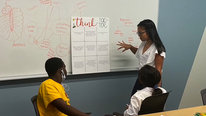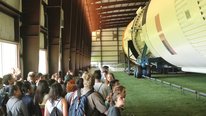- Daniel Serrano
- https://www.linkedin.com/in/dsvolpe
- Senior Faculty Specialist
- Presenter’s NSFRESOURCECENTERS
- University of Maryland College Park
- Taylor Bartlow
- https://www.linkedin.com/in/taylor-bartlow-487153130
- Faculty Assistant
- Presenter’s NSFRESOURCECENTERS
- University of Maryland College Park
- Jason Hipkins
- https://www.linkedin.com/in/jason-hipkins
- Faculty Assistant
- Presenter’s NSFRESOURCECENTERS
- University of Maryland College Park
- Rey Sasaki
- https://www.linkedin.com/in/rey-sasaki-9a377b219
- Undergraduate Student
- Presenter’s NSFRESOURCECENTERS
- University of Maryland College Park
Terps in Space Digital Curriculum
80JSC018M0005
2022 (see original presentation & discussion)
Grades 9-12, Undergraduate
We have developed a 7-module series of videos and worksheets to be used by high school and college educators/mentors who are interested in having their students explore what it means to be a scientist and researcher (with a focus on space science).
Our curriculum uniquely emphasizes a wholistic exploration of science and research as a career, providing students with concrete ideas of what a career in science looks like, and guiding them through the process of team-based experiment design and research proposal writing, thereby experientially exposing them to crucial practices of the scientific career.
We are currently implementing the modules in High School and college population through the University of Maryland Terps in Space program, and obtaining feedback from students and educators in order to develop a distributable version, expected Fall 2022.
Module topics are:
Module 1: So You Want to Be a Researcher? Basic principles of research/science as a profession
Module 2: Teamwork Principles, Diversity and Interdisciplinarity
Module 3: Space Science and Microgravity Principles
Module 4: Navigating the Research Literature
Module 5: Working Around Experimental Constraints
Module 6: Creative Experiment Design: From Idea to Hypothesis
Module 7: Proposal Writing
Our team acknowledges the Student Spaceflight Experiments Program as a significant source of inspiration for the design of these modules.
Related Content for Digital Curriculum to Promote (Space) Science and Research
-
 2022Passion-Driven Statistics
2022Passion-Driven Statistics
Lisa Dierker
-
 2018NASA Academy of Aerospace Quality
2018NASA Academy of Aerospace Quality
Alice Smith
-
 2019Project TRUE - Teens Researching Urban Ecology
2019Project TRUE - Teens Researching Urban Ecology
Jason Aloisio
-
 2021My STEM Story: Students Explore Science Identities
2021My STEM Story: Students Explore Science Identities
Ed Madison
-
 2022STEM Research Inquiry Summer Enrichment (STEM RISE)
2022STEM Research Inquiry Summer Enrichment (STEM RISE)
Mariam Manuel
-
 2020Value of Authentic Research Experiences for HS Students
2020Value of Authentic Research Experiences for HS Students
Margaret Baguio
-
 2018NASA STEM Enhancement in Earth Science H.S. Internship
2018NASA STEM Enhancement in Earth Science H.S. Internship
Margaret Baguio
-
 2020Meet the DO-IT Scholars!
2020Meet the DO-IT Scholars!
Sheryl Burgstahler




Daniel Serrano
Senior Faculty Specialist
Hi, STEM for All attendees! As you'll hear in our video, we have developed a 7-module digital curriculum for high school through college students to explore the science profession by designing an experiment and writing a research proposal. The videos and worksheets are intended for educators to use with their students/mentees, or for students to use independently.
We'd love to hear your questions and perspectives about the project in the Discussion below.
We're currently piloting this curriculum through UMD College Park's Terps in Space program.
We'd love to partner with educators across the US and world to either pilot our current version of the program, or use our final version, expected in Fall 2022.
If you're an educator, organizer, student, etc. and would like to provide feedback about these ideas and/or to collaborate on such initiatives, we'd love to hear from you in the comments or directly.
Diana Muckelrath
Really love learning about space as a educator and teacher myself. I am currently a graduate student, love it if you offered a scholarship to learn this and give it back to my classroom students. Extroidinary information for teachers.
Daniel Serrano
Senior Faculty Specialist
That's a great idea, Diana! We hadn't considered having scholarships or fellowships for educators to come and learn how to use the curriculum and then take it to their classrooms. We'll put this into our list of potential future plans.
Sarah Haavind
Jeff Milbourne
STEM Coordinator-Writing and Learning Center
Thanks to all for the great video, and the great project. I really appreciate the integrated nature of the project, pulling in both conceptual ideas authentic experience/practice from so many different disciplines (module 5 in particular seems really useful). I also think the authentic opportunities available through the Terps in Space Program are great-both in terms of research/design learning opportunities and the opportunity to put a payload in space.
I'm curious about impact and outcomes-you've talked about piloting this curriculum to create a publicly available version soon, but could you talk a little more about how you're thinking about exploring the curriculum's efficacy (defined around whatever dimensions of efficacy you think are appropriate)?
How are you thinking about scaling the program once the public curriculum is available? As the project/curriculum scales, how much capacity do you have within the existing programmatic/partnership framework to continue supporting authentic opportunities like the Terps in Space design challenge?
Again, great program and video.
Sarah Haavind
Daniel Serrano
Senior Faculty Specialist
Thanks for the thoughtful questions, Jeff.
On the first question:
Each of our modules has a set of expectations (e.g.: the student will perform a search of science careers and identify those of interest; the student will annotate a peer reviewed article on the microgravity-related topic of choice) and of learning outcomes (e.g.: the student will gain an understanding of how microgravity affects [x physical phenomenon]).
With those, we expect to be able to build surveys where participants can self-report gains, and also have mentors/teachers do assessment of efficacy. For our current trial run, we developed a feedback survey focused more on the usefulness of the modules to the students.
The struggle we have currently is balancing our philosophy that this program isn't a conventional course that should have quizzes/knowledge tests/etc., with the need to do rigorous assessment. We hope to work with Education Researchers and K-12 practitioners to perfect our plans to determine efficacy.
On the second question:
Our model is to make the materials publicly accessible so other organizations can use their own resources to scale the program. We do have the capacity to collaborate with others by jointly seeking funds to support the flights to ISS, but otherwise our goal is to create public materials for others to use, and continue focusing on our own internal program at UMD College Park and local high schools.
Sarah Haavind
Sarah Haavind
Senior Research Project Manager
Hello Daniel and Terps Team! What a cool way to support and enhance access to an immersive experience in being a space scientist with a design challenge that could actually be picked up in the future. I look forward to your thoughts on Jeff's questions related to efficacy and scaling. In addition, it would be fascinating to hear about some of the proposals you have already seen in development. What sorts of experiments are participants designing? Thanks in advance for sharing more about your work.
Daniel Serrano
Senior Faculty Specialist
Thanks, Sarah!
In the 6 years of the program, we've had ~70 proposals of a large range of topics and levels of creativity. Some more recent examples that come to mind:
- Exploring how adding water in space affects the properties of a new material (video)
- Looking at micro-particle interactions as a way to gain insight into planetary formation (video)
- Exploring the stability of blood coagulation molecules in spaceflight conditions
- Understanding how bacterial biofilms form in space under different types of surfaces
Looping this back to Jeff's question, I think that it would be very interesting to link the quality and creativity of experiments somehow into our assessment of curriculum efficacy.
Sarah Haavind
Bhaskar Upadhyay
Associate Professor
TERPS seems like a good curriculum to encourage greater engagement of high school students in space science. The idea of "scientists" to "writing a proposal" is a very good way to show students how space science is an exciting frontier. However, it is less clear what the modules would delve into on the sciences of space. Also, much of space science teaching seems to lack hands-on work at the high school level, I worry if this curriculum would be any different. I would encourage to see more hands-on work rather than just "thought experiments without hands-on tools".
Daniel Serrano
Senior Faculty Specialist
That's a great point, Bhaskar. We don't implement this very strongly, but students are encouraged to do preliminary experiments as they write their proposal so that they do get hands-on experience. I agree this should be more formally implemented, though it has a good number of logistical difficulties in this type of program because every student team is proposing a different type of experiment, requiring different materials/reagents and equipment.
Efe Frank
Nice presentation on space science. Please, how cost effective are your instrumentations in acquiring experimental data? Are there simulated devices to acquire data for the project?
Daniel Serrano
Senior Faculty Specialist
Hi, Efe. The experimental costs depend on the specific projects that each team proposes. Some of them propose looking at seed germination, so the costs would be low (seeds + water + growth medium). Some students, especially at the college level, propose experiments that require advance instrumentation like electron microscopes. In this case, we tend to rely on institutional resources so that there are no costs to the student team.
Hope this helps, but let me know if I can clarify further.
Further posting is closed as the event has ended.